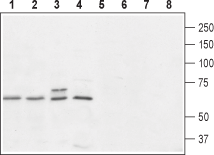Overview
- Peptide (C)RVSVKLRNRVVPGS, corresponding to amino acid residues 247-260 of rat PRLHR (Accession Q64121). 3rd intracellular loop.

 Western blot analysis of rat brain (lanes 1 and 5), mouse brain (lanes 2 and 6), rat cerebellum (lanes 3 and 7) and PC-12 cells (lines 4 and 8):1-4. Anti-PrRP Receptor (GPR10) Antibody (#APR-054), (1:1000).
Western blot analysis of rat brain (lanes 1 and 5), mouse brain (lanes 2 and 6), rat cerebellum (lanes 3 and 7) and PC-12 cells (lines 4 and 8):1-4. Anti-PrRP Receptor (GPR10) Antibody (#APR-054), (1:1000).
5-8. Anti-PrRP Receptor (GPR10) Antibody, preincubated with PrRP Receptor/GPR10 Blocking Peptide (#BLP-PR054).
- D’Ursi, A.M. et al. (2002) J. Med. Chem. 45, 5483.
- Lin, S.H. et al. (2001) Mol. Pharmacol. 60, 916.
- Roland, B.L. et al. (1999) Endocrinology 140, 5736.
- Gu W. et al. (2004) J. Mol. Neurosci. 22, 93.
- Bhattacharyya, S. et al. (2003) Diabetes 52, 1296.
Prolactin-releasing peptide (PrRP) a bioactive peptide, was originally identified as an endogenous ligand of the orphan human G-protein coupled receptor, seven transmembrane domain receptor, GPR10 (hGR3, also called PrRP receptor). Like the majority of orphan receptors, PrRP receptor shows a low level of sequence homology with known GPCRs. Notwithstanding, a certain degree of homology has been reported to members of the neuropeptide Y (NPY) family of receptors. Neuropeptide Y is a 36- residue C-terminally amidated polypeptide hormone and neurotransmitter with the presence of an α-helix involving the 20 C-terminal residues, whereas the N-terminus part seems more flexible and is influenced by the medium environment1. It has been recently demonstrated that the PrRP receptor may modulate neurotransmission specifically at glutamatergic synapses through the interaction with the same PDZ domain proteins that interact with AMPA receptors2.
Binding of PrRP to the receptor results in activation of extracellular signal-related kinase (ERK) in a mainly pertussis toxin sensitive manner, suggesting coupling to Gi/o proteins.
PrRP receptor is expressed in the central nervous system with highest levels in the pituitary. Expression has also been detected in the cerebellum, brainstem, hypothalamus, thalamus, nucleus tractus solitaries, adrenal medulla and spinal cord in rat3.
PrRP is implicated in the regulation of the hypothalamic–pituitary–adrenal axis, blood pressure and nociception4,5. Genetic studies in rodents indicate that lack of PrRP receptor leads to hyperphagia, obesity and dyslipidemia4. In humans, genetic variations in PrRP receptor are associated with lowered blood pressure5.
Application key:
Species reactivity key:
Alomone Labs is pleased to offer a highly specific antibody directed against an epitope of the rat Prolactin-releasing peptide receptor. Anti-PrRP Receptor (GPR10) Antibody (#APR-054) can be used in western blot analysis. It has been designed to recognize PrRPR from human, rat and mouse samples.
